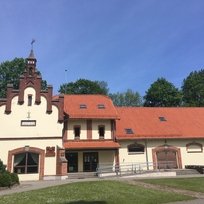The name of the Vėžaičiai settlement has appeared in historical sources since the 16th century. The tributaries of the Minija River – the Skinija and Gerdauja Streams – flow through the town. The history of Vėžaičiai is inseparable from the Vėžaičiai Manor, which was the driving force behind the growth of the entire settlement. The initial data about the Vėžaičiai Manor in historical sources date back to the beginning of the 18th century. The preserved historicist-style structures of the Vėžaičiai Manor were built in the late 19th century. For 300 years, the manor belonged to the Volmer counts. The Vėžaičiai Manor homestead has an architectural, historical and urban value.
The complex homestead structures include a park, a gamekeeper’s house, two gates, a stable, a guard’s house, a vodka distillery building, a cowshed, a barn, the manor house, and a chapel.
The park and the manor buildings were reconstructed in the middle of the 20th century. The entrance to Vēžaičiai Manor has southern (‘white’) and northern (‘red’) gates.
Once, a dense linden-lined avenue led through the park to the manor. The park has a mixed layout and is formed in the western part of the settlement along the Skinija stream. The ensemble of buildings of the former manor is located on the left slope of the stream. The main avenue of the park meanders gently on a low terrace along the bank of the Skinija Stream. The meadow of the high terrace has native linden, birch, rowan, Douglas fir, western red cedar and red oak trees as well as various ornamental shrubs. On the slopes separating the terraces and in the bulrush areas of the Skinija Valley, there are mainly native maple, ash, oak, linden, elm and common chestnut trees.
In 1986, the park gained the status of a natural monument of local significance.
Currently, the best-preserved building part of the manor ensemble is the stable that was restored in the 1990s and revived for something new – cultural life – by a project team: A. Meškauskienė (architect) and P. Ramonas (designer). The stable of the Vėžaičiai manor was built in 1908 and has features of the neo-Gothic style. It has a symmetrical volume with an accentuated corner part. Today, it hosts the Vėžaičiai Cultural Centre, which organises art exhibitions, contemporary dance groups, ethnographic ensemble concerts and dance evenings.
The gamekeeper has also been restored and is now a private estate.
The current territory of the park is used mostly for organising various cultural events. The aim for the future is to restore the former manor buildings and adapt the complex to educational and eco-tourism needs.
The town of Vėžaičiai is inseparable from the annual Annas’ Feast Day (Lith. Oninės). This feast day has been celebrated in Vėžaičiai since 1914.
Not far away from Vėžaičiai lies the village of Pažvelsis – the birthplace of Butkų Juzė, a Lithuanian poet and playwright, a fact that is marked by a sculptural roofed pillar.





Reviews